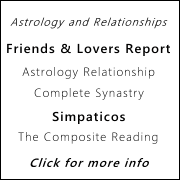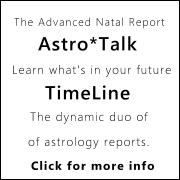Home | Astrology Index | Numerology Index |
Planets in Aspectby Michael McClain
Planetary relationships or aspects in the horoscope
- In astrology, an "aspect" is a geometric relationship between two planets. Aspects are important in analyzing a horoscope because they seem to make the two connected planets function together or be linked. The aspects considered here are just the major ones: the conjunction, sextile, square, trine and opposition. You can find some info on each of these below or go straight to the mini readings on the various planetary aspects by using these links:
The Aspect Graph chart from Astrodienst
- This is perhaps the most difficult area for the beginner since the chart information on aspects is all in symbols. If you are a beginner trying to understand aspects, you will need to obtain the horoscope chart from the Astrodienst Atlas.
-
- netNumerology.com only discusses the major aspects formed by the Sun, the Moon, Mercury, Venus, Mars and Jupiter. There is an aspect grid on the Astrodienst chart in the lower left hand part of the page. The grid shows the aspects that we are interested in, but it also shows some of the minor aspects which are best ignored for now. The major aspects shown on the grid are based on a rather wide orb. An aspect with a very wide orb won't be as strong as ones that are closer to exact. Many of you may wish to figure out the aspects on your own. If you have difficulty figuring the aspects and want to get into this more, visit here for more assistance.
The Conjunction. The conjunction is formed when two planets are at approximately the same degree of the same sign. If this symbol appeared on the fourth row of the graph under the symbol for the Sun, it would mean that the Sun and Venus were in conjunction. If it appeared under the symbol of the Sun on the 10th row it would mean that the Sun and Pluto (see Pluto note below) were in conjunction. In a conjunction, the energies of the two planets are combined, and often the result is a strengthening of both.
Note: The symbol looking like the letters P & L combined on the atlas graph, is the original symbol for Pluto.
 The Sextile. The Sextile.
Sextiles occur when two planets are approximately 60 degrees* apart. This is the aspect of opportunity.
 The Square. The Square.
Squares occur when two planets are approximately 90 degrees* apart. Square cause the friction and the hurdles that causes us to grow and become productive.
 The Trine. The Trine.
A trine occurs when two planets are approximately 120 degrees* apart. Trines bring about ease and comfort.
 The opposition. The opposition.
The opposition occurs when two planets are about 180 degrees* apart. As the name implies, opposition are obstacles that must be resolved.
- *Note that Astrodienst places the number of degrees and minutes that the aspect deviates from the precise aspect in the box under the aspect symbol. The deviation is called the orb. It appears to me that the orb allowed by Astrodienst is too great.
-
Recommended orbs:
- Sun and Moon (sometimes called the lights): conjunctions 8°, squares, trines, oppositions 7°, sextiles 5°
-
 Planets: conjunctions 6°, squares, trines, oppositions 5°, sextiles 3° Planets: conjunctions 6°, squares, trines, oppositions 5°, sextiles 3°
Therefore, I would personally choose to ignore some of the aspects shown on the grid when the orb is larger.
Start with the Sun, then the Moon, and in order, Mercury, Venus and Mars. List all of the aspects that apply. Now go find and record the probable meaning of each aspect.
© Michael McClain 1996-2013. Permission is granted for unlimited noncommercial use. All other rights reserved.
|







|








 The
The  The
The  The
The  The
The  Planets: conjunctions 6°, squares, trines, oppositions 5°, sextiles 3°
Planets: conjunctions 6°, squares, trines, oppositions 5°, sextiles 3°